Developments on peatlands have the potential to create a broad range of impacts, many of which have not been extensively studied. Here we explore some of the major sources of impacts resulting from developments on peatlands. The IUCN UK Peatland Programme has also published a number of more in-depth briefings examining these issues in addition to hosting a session at the 2024 Peatland Programme Conference. These are available here:
Peatlands and Development Briefing
Linear Developments on Peatlands knowledge sharing session (2024 Conference)
Roads and Tracks
Access roads and development on peatlands globally are a growing concern, with seismic exploration tracks in North America and Canada representing the largest disturbance footprint of any human activity1. In the UK, a study which looked at vehicular disturbance on protected peatland sites in the uplands found that the density of surfaced and unsurfaced vehicle tracks exceeded that of the main road network per square kilometre by approximately ten times2. The same study2 also found that 36% of footpaths surveyed in upland areas had evidence of vehicular damage. In the UK there is also pressure to develop degraded peatlands into onshore windfarms, including associated access roads and tracks. Whilst this is more widespread in Scotland at present, a recent (2023) relaxation of the regulations in England has already seen applications for windfarm developments on peatlands being submitted and there are a growing number of applications in Wales.
Controls are in place in the form of the habitat regulations to protect sites, but these only apply to sites which have been designated, leaving those which haven’t vulnerable to development with little to no oversight. Consents for tracks which are surfaced with gravel are generally only granted where there is deemed to be an economic reason or it is in the overwhelming public interest, although these are not always without controversy. Tracks surfaced with plastic mesh are more routinely requested for upland sporting access purposes to facilitate access by low ground pressure vehicles such as Argocats, and are still subject to consenting on designated sites. There are also a small number of tracks made from hardwood ‘sleepers’ which facilitate access by heavier vehicles.
However, there also exist many networks of ad hoc unsurfaced tracks, particularly across remote upland peatlands sites and often with main track areas serving as ‘arteries’ for these tracks. Where temporary tracks are removed there is also a challenge of how to control access to what remains a visible and easily negotiated route that may remain attractive to livestock, deer, and off-road vehicles. Where there is no protective surface, or this has been removed and usage continues, off-road vehicle ruts can be deep and have been found to remain as channels for water for in excess of 18 months3. These ruts may result in the formation of much more problematic erosion features. Where off-road vehicles persistently use tracks, the peat surface can be eroded entirely. Shallow peat surfaces are particularly vulnerable to rapid erosion to the mineral subsoil.
Owing to the low tensile strength of peat, deformation of the substrate occurs readily in ruts where there is no protective surface, even with very low usage rates. Whilst temporary surfaced tracks offer some protection, the footprint of compaction has been found to increase over the entire area of the track as the load of the vehicle pulls the track down from the ruts, compacting the centre in addition. Deformation lasts long after vehicle usage has ceased and research has suggested that it may be permanent4, although further research is required.
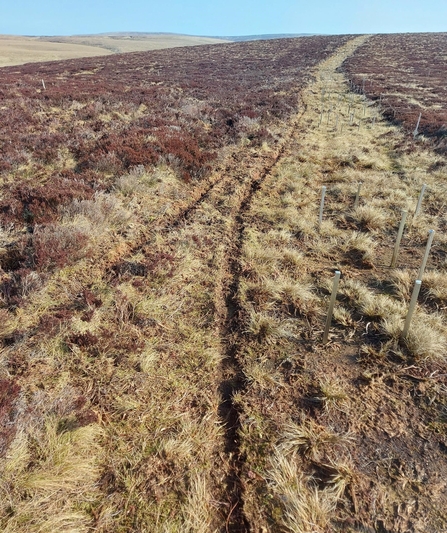
Vehicle damage: single passage made by two dirt bikes in May 2022 on Moor House National Nature Reserve, North Pennines. Credit: Jessica Fìor-Berry.
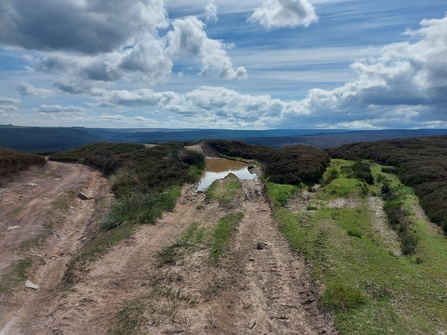
Erosion of shallow peat by illegal four-wheel drive usage results in rutting and pooling, Bollihope, Durham. Credit: Jessica Fìor-Berry.
There are also ecological impacts to consider. As vehicles are driven in from offsite this provides an opportunity for atypical species to colonise, and these may become established, with divergence from the typical bog assemblage resulting. Where temporary tracks are removed there is also a significant impact to the peat vegetation: both structure and composition are significantly altered over long periods of time3. If no restoration is undertaken, the extensive bare peat exposure which occurs in the removal process remains visible over multiple years, with rills resulting from peat erosion due to overland flow4.
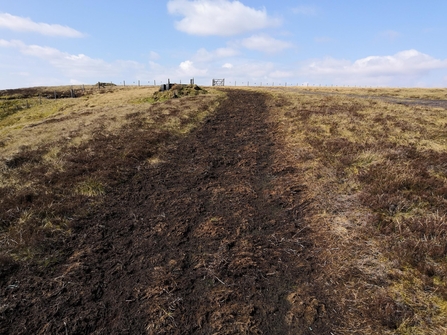
Temporary track removal site in the North Pennines taken 18 months post removal. Credit: Jessica Fìor-Berry.
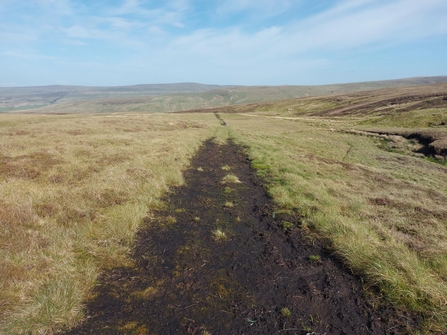
A temporary track removal site in the North Pennines taken 4.5 years post removal. Credit: Jessica Fìor-Berry.
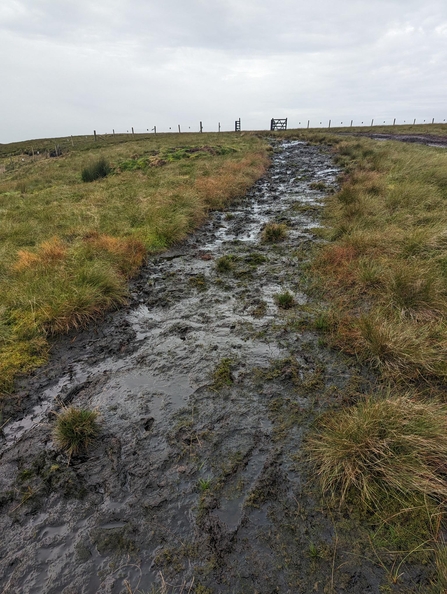
Temporary track removal site in the North Pennines taken 6 years post removal. Credit: Jessica Fìor-Berry.
Windfarm development
Wind farming is an important part of the journey to net zero: whilst offshore wind farming offers the opportunity to build larger scale farms, small scale farms and individual turbines are already a familiar sight in many areas of the UK. To date, windfarm development in Scotland has been more extensive than in the other devolved nations of the UK, although England has seen an increase in applications following relaxation of planning regulations in 2023. There are a growing number of applications in Wales, and although smaller scale, there has been some construction on Northern Ireland blanket bog sites. Developments have not been without controversy both from purely aesthetic and nature conservation points of view.
As onshore wind farms are an emerging issue, there is currently a limited body of evidence regarding their impacts. This means that effects are likely to be extrapolated from other related research areas (e.g., roads and tracks), but there are some specific considerations with windfarms that merit further investigation. Windfarms require significant excavation of the substrate to create roads able to bear heavy vehicles, to provide the foundations for turbines and to bury cables. Whilst there is an understanding of the hydrological impacts of ditch excavation, there has been no research looking at the thermal impacts of cables which may then be buried in these. Oil filled cables will give off heat and this may have a drying effect on the surrounding peat which merits further investigation.
Deep peatlands in the uplands are attractive locations for turbines owing to their exposure and resulting high winds. Credit: Penny Anderson.
Peatlands, which are found largely in remote, exposed locations (in both upland areas and islands such as Shetland and the Outer Hebrides) where high winds are frequent are attractive locations for development. Modelling of emissions from the windfarm development on undamaged peatlands suggests that the greenhouse emissions resulting from the damage will not be offset by the emissions saved by the green energy generated6. As there is a greater shift from fossil fuel dependency to green energy, there are also likely to be diminishing returns in emissions terms on all construction on peatlands, whether damaged or degraded.
The IUCN UK Peatland Programme position is that whilst windfarms are necessary to transition away from fossil fuels, they should not be constructed on peatlands. Moreover, degraded peatlands should not be seen as a ‘write-off’ that can be developed, as they remain important carbon stores and if restored will continue to store and sequester carbon.
Urban development
The creation of housing developments on peat given its unsuitability as an engineering substrate may be surprising. However, particularly in Scotland where peatlands cover 20% of the land and there is a shortage of available and affordable housing in rural areas, this has led to pressure to consider peatlands for development7,8. The traditionally favoured approach has been to excavate the peat and replace it with a solid foundation material (such as aggregate)7. However, less damaging techniques such as mass stabilisation or piling may offer a way to meet the demand for housing without compromising the carbon storage element of the peat7. There would also be negative consequences for the biodiversity component however, as both construction and habitation would cause disturbance.
Whilst the IUCN UK Peatland Programme does not currently have a position statement on urban developments such as housing, we do not support development on these sites for several reasons. Development on peatlands carries significant risks to these habitats - both directly and indirectly by proximity - of being detrimental to the wildlife they support and their physical functioning, and by increasing the risk of landslides or bursts. There should also be consideration given by government and regional bodies about the drivers for housing shortages (such as second homes and holiday lets) and whether it would be better to tackle these issues rather than building houses on peatland sites, which without suitable restrictions (through local occupancy clauses, increased council taxes etc.), may not solve the housing shortage.
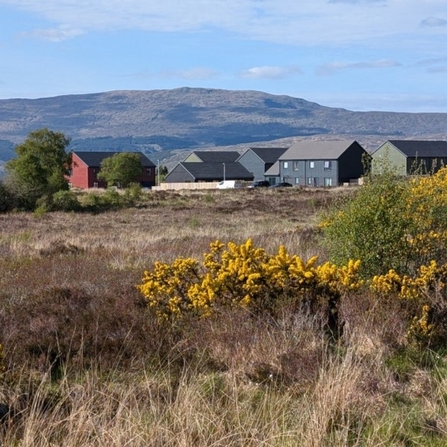
Housing on area cleared of peatland, Fort William, Scotland. Credit: Jess Fìor-Berry
References
1. Williams-Mounsey J, Grayson R, Crowle A, Holden J. A review of the effects of vehicular access roads on peatland ecohydrological processes. Earth-Science Reviews. 2021 Mar 1;214:103528. https://doi.org/10.1016/j.earscirev.2021.103528.
2. Clutterbuck B, Burton W, Smith C, Yarnell RW. Vehicular tracks and the influence of land use and habitat protection in the British uplands. Science of The Total Environment. 2020 Oct 1;737:140243. https://doi.org/10.1016/j.scitotenv.2020.140243.
3. Williams-Mounsey J, Crowle A, Grayson R, Holden J. Removal of mesh track on an upland blanket peatland leads to changes in vegetation composition and structure. Journal of Environmental Management. 2023 Aug;339:117935. https://doi.org/10.1016/j.jenvman.2023.117935.
4. Williams-Mounsey J, Crowle A, Grayson R, Lindsay R, Holden J. Surface structure on abandoned upland blanket peatland tracks. Journal of Environmental Management. 2022 Nov 2;325:116561. https://doi.org/10.1016/j.jenvman.2022.116561.
5. Williams‐Mounsey J, Crowle A, Grayson R, Lindsay R, Holden J. Blanket bogs exhibit significant alterations to physical properties as a result of temporary track removal or abandonment. Ecohydrology. 2024 Feb 2. https://doi.org/10.1002/eco.2623.
6. Smith J, Nayak DR, Smith P. Wind farms on undegraded peatlands are unlikely to reduce future carbon emissions. Energy Policy. 2014 Mar;66:585–91. https://doi.org/10.1016/j.enpol.2013.10.066.
7. Sanchez JB., McDougall J, Medero G, Cook D and Barreto D. Housing Construction on Peatlands, Phase 1 Report. 2021. Available from: Housing Construction On Peatland: Phase 1 Report [accessed 2025 July 23].
8. Tarrant S. New peatland construction methods could unlock further housing developments in rural Scotland [Internet]. www.highland.gov.uk. Available from: https://www.highland.gov.uk/news/article/13757/new_peatland_construction_methods_could_unlock_further_housing_developments_in_rural_scotland [accessed 2025 May 9].
